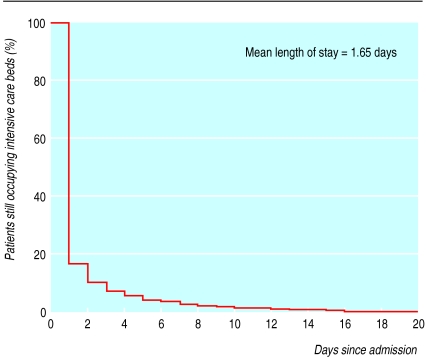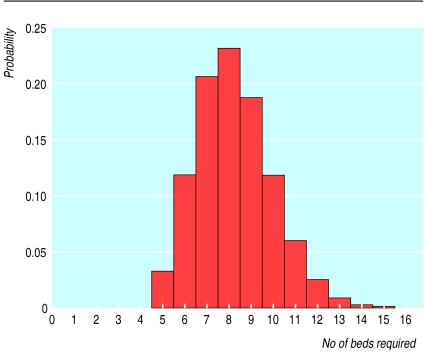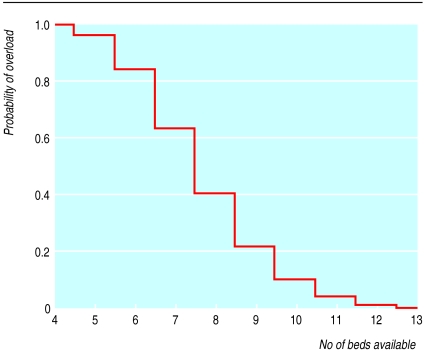Abstract
Objectives
To investigate the variability of patients' length of stay in intensive care after cardiac surgery. To investigate potential interactions between such variability, booked admissions, and capacity requirements.
Design
Mathematical modelling study using routinely collected data.
Setting
A cardiac surgery department.
Source of data
Hospital records of 7014 people entering intensive care after cardiac surgery.
Main outcome measures
Length of stay in intensive care; capacity requirements of an intensive care unit for a hypothetical booked admission system.
Results
Although the vast majority of patients (89.5%) had a length of stay in intensive care of ⩽48 hours, there was considerable overall variability and the distribution of stays has a lengthy tail. A mathematical model of the operation of a hypothetical booking system indicates that such variability has a considerable impact on intensive care capacity requirements, indicating that a high degree of reserve capacity is required to avoid high rates of operation cancellation because of unavailability of suitable postoperative care.
Conclusion
Despite the considerable enthusiasm for booked admissions systems, queuing theory suggests that caution is required when considering such systems for inpatient admissions. Such systems may well result in frequent operational difficulties if there is a high degree of variability in length of stay and where reserve capacity is limited. Both of these are common in the NHS.
What is already known in this topic
Booking systems for hospital admissions have considerable potential benefits for patients in terms of peace of mind and planning their lives, but these benefits are dependent on having a low cancellation rate
What this study adds
Variability in length of stay can have a major impact on hospital operation and capacity requirements.
Operational research techniques can be used to explore this impact
If variability in length of stay is substantial, as is common, then booked admission systems may require considerable reserve capacity if cancellation rates are to be kept low
Introduction
In the United Kingdom there is considerable interest in the notion of booked admissions, whereby patients are told the date they will be admitted to hospital possibly months in advance. This would be of considerable benefit to patients, both in terms of peace of mind and the practicalities of being able to plan their lives. Such benefits have been assessed,1 but they are so clear that some might wonder why booking admissions wasn't introduced decades ago. After all, it seems to present no problem in many other services. One can book an aircraft flight months in advance, so why not a hospital admission?
Scheduling and queuing are complex issues that arise in many contexts including manufacturing, telecommunications, and transport. Operational research, the mathematical field that covers such matters, has shown that if a system is operating close to capacity changes in control strategies can have drastic consequences. For example, well intentioned changes to the strategy used to control traffic lights in an urban road network can, if the system is operating close to capacity, result in gridlock.
Does this have any relevance to hospitals? Hospitals are complex organisations, and many operate close to capacity. If hospital operation is indeed delicately balanced close to overload, could the introduction of a booking system degrade performance? There are three key factors: reserve capacity, unpredictable variability, and blocking. The interaction between these has a major impact on the efficient operation of hospitals, and various operational research studies have investigated such issues.2–11 Surprisingly, in practice relatively little attention seems to be paid to the variability of length of stay. Equally, it is uncommon to keep records related to constituent parts of a hospital episode, such as the time spent in intensive care or in a high dependency unit.
In this paper we consider the variability of the length of stay in intensive care after cardiac surgery. Although this provides useful information in its own right, the main purpose of the paper is to discuss a mathematical model that uses such information to examine the capacity implications of booking surgical admissions.
Data sources and methods
From the computerised records of patients receiving cardiac surgery at St George's Hospital NHS Trust, we extracted data for all operations except transplants carried out between 1 January 1992 and 16 February 2000 (7014 cases). We classified the operations as coronary artery bypass grafting, valve replacement, or “other,” and we recorded the number of days each patient spent in intensive care as a whole number. These data cover patients who were eventually discharged from hospital and those who died.
We calculated the percentage of patients still in intensive care after a given number of days (for 1-20 days) using the proportions of patients with those lengths of stay. We then devised a mathematical model based on probability theory to examine the effects of variability of length of stay on capacity requirements in the context of a booking system. As is common with mathematical modelling, many of the complexities of real life hospital operation were neglected, the purpose being to examine the principles underlying the process. Within the model, it is assumed that a regular and unvarying number of operations are booked each day, each performed successfully, and each resulting in a patient being admitted to a dedicated cardiac surgery intensive care unit for postoperative recovery. Patients are assumed to remain in intensive care for a whole number of days, the duration of their stay having a prespecified probability distribution. Patients are assumed to be homogeneous in that the same length of stay distribution applies to each. Lengths of stay are assumed to be independent of one another and independent of the number of beds occupied.
We wrote a computer program to perform the computations required to calculate the long term probability of a given number of beds being occupied. For illustrative purposes, we have run the program using the length of stay distribution derived from the data shown in the table. The hypothetical booking system investigated had five operations booked a day, a figure chosen as a plausible level of activity.
Results
Figure 1 shows the proportion of the 7014 patients still in intensive care after a given number of days. The mean length of stay (1.65 days) gives an indication of the mean requirements for intensive care beds. The median length of stay and the upper limit of the interquartile range were one day.
Figure 1.
Proportion of 7014 patients who underwent cardiac surgery still in intensive care by days after admission
From our mathematical model we calculated the probabilities of different numbers of beds being occupied (fig 2). These are calculated from the number of cases assumed to be booked each day and the distribution of length of stay. The probability distribution is centred on the number of beds that would be required if there were no variability in length of stay. The tails of the distribution occur as a consequence of the variability. If, by chance, a group of patients are booked whose postoperative care takes longer than average then more beds would be occupied. The upper tail of the distribution indicates the probability of such an occurrence.
Figure 2.
Probability distribution for the number of intensive care beds occupied after cardiac surgery
Figure 3 shows another way of interpreting this information—as the probability that the number of beds required exceeds a given level. Depending on the actual number of beds in the intensive care unit, this reflects the proportion of booked operations for which additional intensive care capacity would have to be made available.
Figure 3.
Probability that the number of intensive care beds required after cardiac surgery exceeds a given level
Discussion
Our results show that most of the patients who underwent cardiac surgery had a relatively short stay in intensive care. However, there was substantial variation, and it would be unwise to ignore such variability when evaluating or designing surgical booking systems. Unfortunately, information about this variability is rarely available to hospital managers.
Problems with booking hospital admissions
Considerable patient benefits would follow from introducing booking systems where it is feasible to do so. Early indications are that such systems can work effectively in day case surgery.1 With inpatient admissions, however, variability in length of stay becomes important. Our mathematical model shows how this variability poses a fundamental problem for booking admissions. The average length of stay was 1.65 days. Since five operations a day were assumed, this corresponds to an average requirement of 8.25 beds. Ignoring variability in length of stay, an eight or nine bed intensive care unit would seem appropriate. However, variation in length of stay means that operating an intensive care unit with eight beds would lead to operational overload 41% of the time (for a nine bed unit, this figure would be 22%). Increasing the number of beds to give reserve capacity would be the only option. However, to reduce the chances of operational overload to 5% or less, as many as 11 beds might be required. This would correspond to maintaining a unit with over 30% reserve capacity. This is clearly possible, but expensive.
To make matters worse our mathematical model is deliberately simplistic, the philosophy being that a booking system that fails to operate effectively when applied in simple circumstances stands little chance when used in the real world. Two unrealistic assumptions are implicit in our model. It is assumed that the same number of cases are booked each day, irrespective of the day of the week. To reflect real life practice, a booking system would have to take account of effects such as weekend working and staff availability. Also, our model does not take into account that there would be a limited number of beds available (including any reserve capacity) and that an operation would be cancelled if no bed were available for postoperative intensive care. Booking systems therefore have to allow for such cases to be rebooked—for example, by leaving gaps in the admissions diary. This again makes demands for reserve capacity. Obviously, the less reserve capacity available in the form of extra beds there is, the more reserve capacity is required in the admissions diary, and vice versa. The need for reserve capacity is, however, inescapable.
Another important issue that we have not considered explicitly is that of bed blockage. In practice a patient will leave cardiac intensive care to be moved to a high dependency unit. If no bed is available, however, the patient may well have to stay in intensive care. This makes the process of booking admissions even harder. Not only is substantial reserve capacity required in the intensive care unit, but also at all subsequent stages of the patients' care. The length of stay distribution that we used here will almost certainly contain instances of such blocking, but these have not been recorded.
Such real life practicalities make the design of inpatient surgical booking systems challenging. Operational research models can be of great help to clinicians and managers considering introducing such systems. Simple models, such as that presented here, can help clinicians and managers decide whether to attempt to introduce such systems in a particular department. In principle, more sophisticated models could take into account factors such as bed blockage, staff availability, emergency admissions, and non-attendance and could support decisions about how best to operate a booking system. However, models do not need to replicate the full complexity of hospital operation to provide useful insights about the interplay of key factors. Indeed, models that attempt to do so can hinder understanding with confusing and irrelevant detail.
Conclusions
Our findings suggest that variability of length of stay is a key determinant of effective hospital operation. When variability is substantial, which is common, the introduction of booked admissions systems may be inadvisable unless there is considerable reserve capacity.
When making an analogy between booking surgical inpatient admissions and other forms of scheduling, it is unwise to think that simple tasks such as booking flight tickets are comparable. Planes may be infuriatingly late, but one generally knows to the hour how long a flight is going to take once the plane has taken off and that, when it lands, all the passengers will get off. Predicting the course of preoperative and postoperative care is much more uncertain, even as it is going on let alone months in advance. Average stays say little about the number of patients who linger. Hospital dynamics may be much closer to those of congested urban traffic control. Unless considerable reserve capacity is available, introducing inpatient booking systems might well run the risk of doing to the health service what Michael Caine and his crooks did to the streets of Turin in the film The Italian Job.
Supplementary Material
Table.
Length of stay in intensive care of 7014 patients who underwent cardiac surgery (except transplants)
| Length of stay (days) | No (%) of patients (n=7014) |
|---|---|
| 1 | 5820 (83.0) |
| 2 | 457 (6.5) |
| 3 | 220 (3.1) |
| 4 | 111 (1.6) |
| 5 | 84 (1.2) |
| 6 | 53 (0.8) |
| 7 | 58 (0.8) |
| 8 | 41 (0.6) |
| 9 | 29 (0.4) |
| >9 | 141 (2.0) |
Footnotes
Editorial by Buhaug
Funding: None received
Competing interests: None declared.
Details of the mathematical calculations used appear on bmj.com
References
- 1.Kipping R, Meredith P, McLeod H, Ham C. Booking patients for hospital care: a progress report. Second interim report from the evaluation of the national booked admissions programme first-wave pilots, 2000, www.bham.ac.uk/hsmc
- 2.Millard PH, Mackay M, Vasilakis C, Christodoulou G. Measuring and modelling surgical bed usage. Ann R Coll Surg Engl. 2000;82:75–82. [PMC free article] [PubMed] [Google Scholar]
- 3.Mackay M, Millard PH. Application and comparison of two modelling techniques for hospital bed management. Austr Health Rev. 1999;22(3):118–143. doi: 10.1071/ah990118. [DOI] [PubMed] [Google Scholar]
- 4.Goodyear OM, Sozou PD, Gallivan S. Forecasting of hospital waiting lists in a trauma and orthopaedic department: computational methods based on finite-period queuing methods. In: Richards B, editor. Current perspectives in healthcare computing (HC98). Weybridge: BJHC Books; 1998. pp. 345–352. [Google Scholar]
- 5.Goodyear OM, Gallivan S, Sozou PD. Can queuing theory be applied to hospital waiting lists? In: Richards B, editor. Current perspectives in healthcare computing (HC97). Weybridge: BJHC Books; 1997. pp. 316–324. [Google Scholar]
- 6.Worthington DJ. Hospital waiting list management models. J Operational Res Soc. 1991;42:833–843. doi: 10.1057/jors.1987.69. [DOI] [PubMed] [Google Scholar]
- 7.Worthington DJ. Queueing models for hospital waiting lists. J Operational Res Soc. 1987;38:413–422. doi: 10.1057/jors.1987.69. [DOI] [PubMed] [Google Scholar]
- 8.Harris RA. Hospital bed requirements planning. Eur J Operational Res. 1986;25:121–126. [Google Scholar]
- 9.Vissers J, Wijndgaard J. The outpatient appointment system: design of a simulation study. Eur J Operational Res. 1979;13:459–463. [Google Scholar]
- 10.Jackson RRP, Welch JD, Fry J. Appointment systems in hospitals and general practice. Operational Res Q. 1964;15:219–237. [Google Scholar]
- 11.Bailey NT. A study of queues and appointment systems in hospital outpatient departments. J R Statistical Soc. 1952;14:185–199. doi: 10.1016/s0140-6736(52)90763-0. [DOI] [PubMed] [Google Scholar]
Associated Data
This section collects any data citations, data availability statements, or supplementary materials included in this article.





